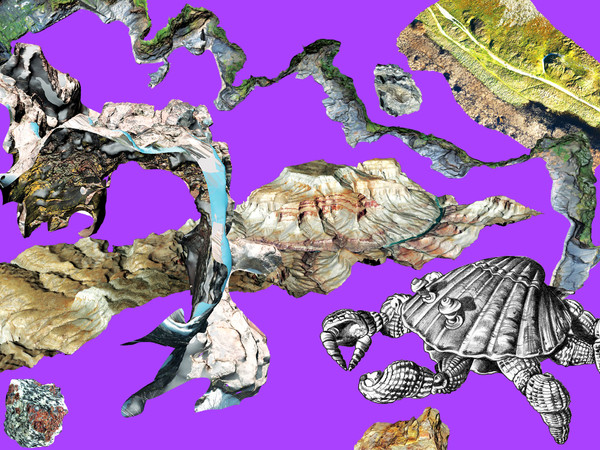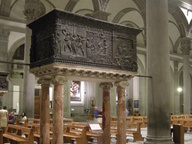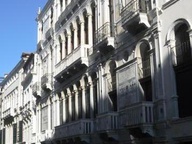Best Before. Giada Fiorindi + Federico Floriani

Best Before. Giada Fiorindi + Federico Floriani
From 26 Gennaio 2018 to 28 Febbraio 2018
Milan
Place: Dimora Artica
Address: via Matteo Maria Boiardo 11
Times: by appointment
Telefono per informazioni: +39 380 5245917
E-Mail info: dimoraartica@gmail.com
Official site: http://www.dimoraartica.com/
Dimora Artica presents Best Before by Giada Fiorindi and Federico Floriani. Inspired by the speculative fabulation of the eco-feminist writer Donna J. Haraway, the exhibition emphasises the idea of containing the dramatic establishment of the Anthropocene with the threat of the Gorgons, mythological creatures with the power to turn anyone who set eyes on them to stone.
Many scientists say that the Earth will become close to uninhabitable by the end of this century and even ancient prophecies coming true don’t seem to affect the mainstream opinion. The artistic duo reflects with sarcasm on these topics and gives shape to a collection of hybrid objects that juxtapose industrial and organic, science and superstition, past and future, all in a halo of kitsch.
The Gorgons, daughters of primordial sea divinities, stand for the three forms of perversion: intellectual, moral and sexual, each one is represented by the three fish tanks in the show. The artificial landscapes are virtually eradicated from the basins to be reproduced on fluid shaped sculptures with an industrial printing technique commonly used in the automotive industry. Then the diorama becomes digital and stratifies like a rock, using photography, 3D models and pencil drawings each with a contrasting layer of meaning.
Since ancient times, changes in the weather have always been perceived as prophetic. The barometric figurines at Dimora Artica, typical touristic gadgets, reveal the climate change with wavering chromatic variations, metaphors of an ecological and intellectual chaos. Instead of the traditional Colosseum, dolphin or Virgin Mary statuettes, surprisingly it is a fossil relic of Anthropos instead that turns from blue to pink in the exhibition.
The project is presented as an hypothetical stratigraphic study of a geological era in the near future. The speculation focuses on a soil formation, which nature is the result of both human activities and the mineralisation of the protagonist of this epic climate destruction himself.
This is how the catastrophe fulfils. Relentless and unconcerned, humans carry on exploiting fossil fuel, boosting global warming, increasing the ocean acidification and sucking every last drop of Medusa’s blood. Even when faced with her revenge, accepting his transformation into fossil material is inevitable, as long as the devastating economic cycle does not have to stop.
The pieces convey the idea of the arts of living in a damaged planet or of life in the ruins, quoting the anthropologist Anna Tsing, and together form an apotropaic installation. Medusa is still present in a domestic context as the ancient Gorgoneions were in the Greek houses of the past, reminding us today of the danger of the sixth mass extinction.
The mythical vision of Best Before sits within a contemporary frame of ecological crisis, portraying today’s society in a condition of cultural, moral and aesthetic decadence while provoking the audience to think with an ironic and nihilistic tone of voice.
Giada Fiorindi and Federico Floriani’s work places itself within an interdisciplinary artistic practice. Both coming from a Design background and a Dutch formation, they joint their narrative priorities as well as their medias during the last year. The result is an eclectic production where images apply to unexpected surfaces, material research combine with digital works and new shapes to storytelling. Moved by the interest on the communicative and symbolic potential of commodities, the newborn duo is engaged in a formal exploration on decoration. The two initiated a reflection upon the ancient ornament value and its resulting present meaning, with a focus on the contemporary cultural crisis. Together, the two artists aim to develop a critical standpoint and a speculative language around the perception of commercial products that are, according to their view, aesthetic and functional projection of a time of decadence.
Many scientists say that the Earth will become close to uninhabitable by the end of this century and even ancient prophecies coming true don’t seem to affect the mainstream opinion. The artistic duo reflects with sarcasm on these topics and gives shape to a collection of hybrid objects that juxtapose industrial and organic, science and superstition, past and future, all in a halo of kitsch.
The Gorgons, daughters of primordial sea divinities, stand for the three forms of perversion: intellectual, moral and sexual, each one is represented by the three fish tanks in the show. The artificial landscapes are virtually eradicated from the basins to be reproduced on fluid shaped sculptures with an industrial printing technique commonly used in the automotive industry. Then the diorama becomes digital and stratifies like a rock, using photography, 3D models and pencil drawings each with a contrasting layer of meaning.
Since ancient times, changes in the weather have always been perceived as prophetic. The barometric figurines at Dimora Artica, typical touristic gadgets, reveal the climate change with wavering chromatic variations, metaphors of an ecological and intellectual chaos. Instead of the traditional Colosseum, dolphin or Virgin Mary statuettes, surprisingly it is a fossil relic of Anthropos instead that turns from blue to pink in the exhibition.
The project is presented as an hypothetical stratigraphic study of a geological era in the near future. The speculation focuses on a soil formation, which nature is the result of both human activities and the mineralisation of the protagonist of this epic climate destruction himself.
This is how the catastrophe fulfils. Relentless and unconcerned, humans carry on exploiting fossil fuel, boosting global warming, increasing the ocean acidification and sucking every last drop of Medusa’s blood. Even when faced with her revenge, accepting his transformation into fossil material is inevitable, as long as the devastating economic cycle does not have to stop.
The pieces convey the idea of the arts of living in a damaged planet or of life in the ruins, quoting the anthropologist Anna Tsing, and together form an apotropaic installation. Medusa is still present in a domestic context as the ancient Gorgoneions were in the Greek houses of the past, reminding us today of the danger of the sixth mass extinction.
The mythical vision of Best Before sits within a contemporary frame of ecological crisis, portraying today’s society in a condition of cultural, moral and aesthetic decadence while provoking the audience to think with an ironic and nihilistic tone of voice.
Giada Fiorindi and Federico Floriani’s work places itself within an interdisciplinary artistic practice. Both coming from a Design background and a Dutch formation, they joint their narrative priorities as well as their medias during the last year. The result is an eclectic production where images apply to unexpected surfaces, material research combine with digital works and new shapes to storytelling. Moved by the interest on the communicative and symbolic potential of commodities, the newborn duo is engaged in a formal exploration on decoration. The two initiated a reflection upon the ancient ornament value and its resulting present meaning, with a focus on the contemporary cultural crisis. Together, the two artists aim to develop a critical standpoint and a speculative language around the perception of commercial products that are, according to their view, aesthetic and functional projection of a time of decadence.
SCARICA IL COMUNICATO IN PDF
COMMENTI

-
 Dal 31 gennaio 2024 al 04 maggio 2025
Fermo | Palazzo dei Priori
Dal 31 gennaio 2024 al 04 maggio 2025
Fermo | Palazzo dei Priori
-
 Dal 20 dicembre 2024 al 04 maggio 2025
Fermo | Palazzo dei Priori
Dal 20 dicembre 2024 al 04 maggio 2025
Fermo | Palazzo dei Priori
-
 Dal 20 dicembre 2024 al 04 maggio 2024
Gorizia | Palazzo Attems Petzenstein
Dal 20 dicembre 2024 al 04 maggio 2024
Gorizia | Palazzo Attems Petzenstein
-
 Dal 18 dicembre 2024 al 18 dicembre 2024
Venezia | Museo Correr
Dal 18 dicembre 2024 al 18 dicembre 2024
Venezia | Museo Correr
-
 Dal 14 dicembre 2024 al 02 marzo 2025
Palermo | Palazzo Abatellis
Dal 14 dicembre 2024 al 02 marzo 2025
Palermo | Palazzo Abatellis
-
 Dal 12 dicembre 2024 al 23 febbraio 2025
Roma | Palazzo Altemps
Dal 12 dicembre 2024 al 23 febbraio 2025
Roma | Palazzo Altemps


